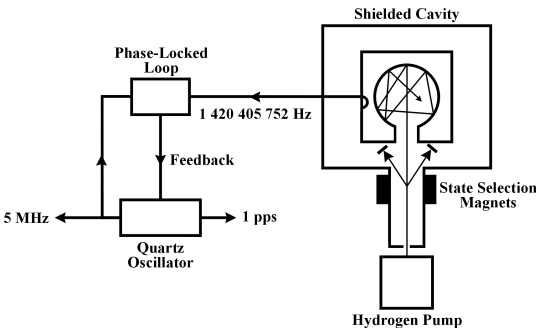Time and Frequency from A to Z, H
The standard unit of frequency, equivalent to one event, or cycle per second. The abbreviation for hertz is Hz.
A technique that generates new frequencies by mixing two or more signals together. For example, a superheterodyne radio receiver converts any selected incoming radio frequency by heterodyne action to a common intermediate frequency (such as the 455 kHz frequency used by many AM radios). The heterodyne technique is sometimes utilized to increase the resolution of time and frequency measurement systems, including the dual mixer time difference system, by converting the incoming signal from the device under test to a lower frequency.
The area of the radio spectrum ranging from 3 to 30 MHz, commonly known as shortwave. The carrier frequencies of 5, 10, and 15 MHz within this spectrum are internationally allocated for time and frequency radio broadcasts, and are used by a number of stations, including NIST radio stations WWV and WWVH.
The hydrogen maser is the most elaborate and expensive commercially available frequency standard. The word maser is an acronym that stands for microwave amplification by stimulated emission of radiation. Masers operate at the resonance frequency of the hydrogen atom, which is 1,420,405,752 Hz.
A hydrogen maser works by sending hydrogen gas through a magnetic gate that only allows atoms in certain energy states to pass through. The atoms that make it through the gate enter a storage bulb surrounded by a tuned, resonant cavity. Once inside the bulb, some atoms drop to a lower energy level, releasing photons of microwave frequency. These photons stimulate other atoms to drop their energy level, and they in turn release additional photons. In this manner, a self-sustaining microwave field builds up in the bulb. The tuned cavity around the bulb helps to redirect photons back into the system to keep the oscillation going. The result is a microwave signal that is locked to the resonance frequency of the hydrogen atom and that is continually emitted as long as new atoms are fed into the system. This signal keeps a quartz oscillator in step with the resonance frequency of hydrogen, as shown in the figure.

The resonance frequency of hydrogen is much lower than that of cesium, but the resonance width of a hydrogen maser is usually just a few hertz. Therefore, the Q is about 109, or at least one order of magnitude better than that of a commercial cesium standard. As a result, the short-term stability is better than that of a cesium standard, typically less than 1 × 10-12 at tau = 1 s, and reaching a noise floor of approximately 1 × 10-15 after about 1 day. However, when measured for more than a few days or weeks, a hydrogen maser might fall below a cesium oscillator’s performance, due to changes in the cavity’s resonance frequency over time.

